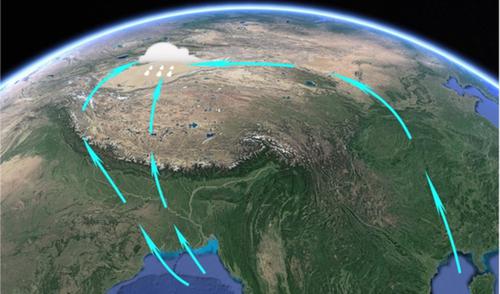当前位置:
X-MOL 学术
›
Int. J. Climatol.
›
论文详情
Our official English website, www.x-mol.net, welcomes your
feedback! (Note: you will need to create a separate account there.)
Increasing summer precipitation in arid Central Asia linked to the weakening of the East Asian summer monsoon in the recent decades
International Journal of Climatology ( IF 3.5 ) Pub Date : 2020-07-02 , DOI: 10.1002/joc.6727 Chunzhu Chen 1 , Xiaojian Zhang 2 , Huayu Lu 2 , Liya Jin 3 , Yan Du 4 , Fahu Chen 5
International Journal of Climatology ( IF 3.5 ) Pub Date : 2020-07-02 , DOI: 10.1002/joc.6727 Chunzhu Chen 1 , Xiaojian Zhang 2 , Huayu Lu 2 , Liya Jin 3 , Yan Du 4 , Fahu Chen 5
Affiliation

|
It is generally believed that water vapour from the North Atlantic transported by the mid‐latitude westerlies dominates precipitation variations in arid Central Asia, where monsoonal water vapour source is beyond the reach. This study reexamines water vapour sources for arid Central Asia based on daily reanalysis data. The results reveal two water vapour sources for arid Central Asia: the westerly water vapour transport from the North Atlantic and the monsoonal water vapour transport from the tropical Indian Ocean and South China Sea. The monsoonal transport includes two pathways: lower tropospheric water vapour along the eastern and northern periphery of the Tibetan Plateau from the tropical Indian Ocean and South China Sea, and middle‐upper tropospheric water vapour via the Tibetan Plateau from the tropical Indian Ocean. Precipitation variability during the monsoonal transport events explains 81% of the total variance. The monsoonal transport is related to a weakened East Asian summer monsoon (EASM) that is accompanied by persistent westward shift of the western Pacific subtropical high and increasing frequency of Mongolian anticyclone activities. The EASM has experienced a persistent weakening trend since 1958, causing an increasing contribution of the monsoonal water vapour transport and thereby enhancing summer precipitation in arid Central Asia. In particular, the monsoonal easterly water vapour has become the dominant source for arid Central Asia in the lower troposphere during the last decade. This study highlights the important role of the EASM in the wetting trend of summers in arid Central Asia during the past six decades.
中文翻译:

近几十年来,干旱中亚的夏季降水增加与东亚夏季风的减弱有关
人们普遍认为,中纬度西风输送的北大西洋水汽是干旱中亚地区降水变化的主要因素,那里季风水汽源是遥不可及的。这项研究根据每日的重新分析数据,重新检查了干旱中亚的水蒸气来源。结果揭示了干旱中亚的两个水汽来源:北大西洋的西风水汽输送和热带印度洋和南海的季风水汽输送。季风运输包括两条途径:热带印度洋和南海沿青藏高原东部和北部外围的对流层低层水汽,热带印度洋沿青藏高原的对流层中高层。季风运输过程中的降水变化解释了总变化的81%。季风运输与东亚夏季风减弱(EASM)有关,伴随着西太平洋副热带高压持续向西移动和蒙古反气旋活动频繁。自1958年以来,EASM一直处于持续减弱的趋势,导致季风水蒸气输送的贡献增加,从而增加了干旱中亚地区的夏季降水。特别是在过去十年中,季风向东的水蒸气已成为对流层低层干旱中亚的主要来源。这项研究突出了EASM在过去六十年中在干旱中亚夏季的湿润趋势中的重要作用。
更新日期:2020-07-02
中文翻译:

近几十年来,干旱中亚的夏季降水增加与东亚夏季风的减弱有关
人们普遍认为,中纬度西风输送的北大西洋水汽是干旱中亚地区降水变化的主要因素,那里季风水汽源是遥不可及的。这项研究根据每日的重新分析数据,重新检查了干旱中亚的水蒸气来源。结果揭示了干旱中亚的两个水汽来源:北大西洋的西风水汽输送和热带印度洋和南海的季风水汽输送。季风运输包括两条途径:热带印度洋和南海沿青藏高原东部和北部外围的对流层低层水汽,热带印度洋沿青藏高原的对流层中高层。季风运输过程中的降水变化解释了总变化的81%。季风运输与东亚夏季风减弱(EASM)有关,伴随着西太平洋副热带高压持续向西移动和蒙古反气旋活动频繁。自1958年以来,EASM一直处于持续减弱的趋势,导致季风水蒸气输送的贡献增加,从而增加了干旱中亚地区的夏季降水。特别是在过去十年中,季风向东的水蒸气已成为对流层低层干旱中亚的主要来源。这项研究突出了EASM在过去六十年中在干旱中亚夏季的湿润趋势中的重要作用。











































 京公网安备 11010802027423号
京公网安备 11010802027423号